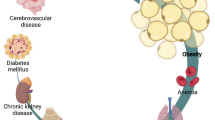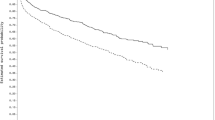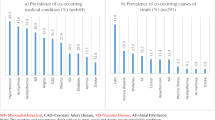Abstract
Background
Comorbidity is related to poor health results in chronic heart failure (HF).
Aims
The purpose of the study was to assess whether a high Charlson Comorbidity Index score (CCI) relates to 1 year mortality after a first hospitalization for acute HF (AHF).
Methods
We reviewed the medical records of 897 patients > 65 years of age admitted within a two-year period because of a first episode of AHF. We analyzed two groups: low (CCI ≤ 2) and high (CCI > 2) comorbidity.
Results
Patients’ mean CCI was 2.2 ± 1.7; 344 patients (38.35%) had a CCI > 2. 1-year all-cause mortality rate in the high comorbidity group was 32.6%, worse than that among low comorbidity group patients (23.7%, p = 0.002). Cox multivariate analysis identified a CCI > 2 as an independent risk factor for 1-year mortality (p = 0.002; HR: 1.525; CI 95% 1.161–2.003), along with older age, history of arterial hypertension, and higher admission heart rate and serum potassium values. Analyzing CCI as a continuous variable, the association remained is also significant (p = 0.0001; HR 1.145; CI 95% 1.069–1.854).
Conclusions
Higher global comorbidity (CCI > 2) at the time of a first hospitalization because of AHF is an independent predictor of mid-term post-discharge mortality among elderly HF patients.

Similar content being viewed by others
References
Gotsman I, Zwas D, Planer D et al (2008) Clinical outcome of patients with heart failure and preserved left ventricular function. Am J Med 121:997–1001
Zarrinkoub R, Wettermark B, Wändell P et al (2013) The epidemiology of heart failure, based on data for 2.1 million inhabitants in Sweden. Eur J Heart Fail 15:995–1002
Conde-Martel A, Hernández-Meneses M (2016) Prevalence and prognostic meaning of comorbidity in heart failure. Rev Clin Esp 216:222–228
Ruiz-Laiglesia FJ, Sánchez-Marteles M, Pérez-Calvo JI et al (2014) Comorbidity in heart failure. Results of the Spanish RICA Registry. QJM 107:989–994
Charlson ME, Pompei P, Ales KL, MacKenzie CR (1987) A new method of classifying prognostic comorbidity in longitudinal studies: development and validation. J Chronic Dis 40:373–383
Schneeweiss S, Maclure M (2000) Use of comorbidity scores for control of confounding in studies using administrative databases. Int J Epidemiol 29:891–898
Testa G, Cacciatore F, Galizia G et al (2009) Charlson Comorbidity Index does not predict long-term mortality in elderly subjects with chronic heart failure. Age Ageing 38:734–740
Oudejans I, Mosterd A, Zuithoff NP, Hoes AW (2012) Comorbidity drives mortality in newly diagnosed heart failure: a study among geriatric outpatients. J Card Fail 18:47–52
Jong P, Vowinckel E, Liu PP, Gong Y, Tu JV (2002) Prognosis and determinants of survival in patients newly hospitalized for heart failure: a population-based study. Arch Intern Med 162:1689–1694
Formiga F, Masip J, Chivite D, Corbella X (2017) Applicability of the Heart Failure Readmission Risk score: a first European study. Int J Cardiol 236:304–309
Fraccaro P, Kontopantelis E, Sperrin M et al (2016) Predicting mortality from change-over-time in the Charlson Comorbidity Index: a retrospective cohort study in a data-intensive UK health system. Medicine (Baltimore) 95:e4973
Chan TC, Luk JK, Chu LW, Chan FH (2014) Validation study of Charlson Comorbidity Index in predicting mortality in Chinese older adults. Geriatr Gerontol Int 14:452–457
Nobili A, Licata G, Salerno F et al (2011) Polypharmacy, length of hospital stay, and in-hospital mortality among elderly patients in internal medicine wards. The REPOSI study. Eur J Clin Pharmacol 67:507–519
Li B, Evans D, Faris P, Dean S, Quan H (2008) Risk adjustment performance of Charlson and Elixhauser comorbidities in ICD-9 and ICD-10 administrative databases. BMC health Serv Res 8:12
Rodríguez-Pascual C, Vilches-Moraga A, Paredes-Galán E, Ferrero-Marinez AI, Torrente-Carballido M, Rodríguez-Artalejo F (2012) Comprehensive geriatric assessment and hospital mortality among older adults with decompensated heart failure. Am Heart J 164:756–762
Mentz RJ, Kelly JP, von Lueder TG et al (2014) Noncardiac comorbidities in heart failure with reduced versus preserved ejection fraction. J Am Coll Cardiol 64:2281–2293
Author information
Authors and Affiliations
Corresponding author
Ethics declarations
Conflict of interest
The authors declare that they have no conflict of interest.
Funding
This research did not receive any specific grant from funding agencies in the public, commercial, or not-for-profit sectors.
Statement of human and animal rights
The study has been approved by the ethics committee of the Bellvitge hospital.
Rights and permissions
About this article
Cite this article
Formiga, F., Moreno-Gonzalez, R., Chivite, D. et al. High comorbidity, measured by the Charlson Comorbidity Index, associates with higher 1-year mortality risks in elderly patients experiencing a first acute heart failure hospitalization. Aging Clin Exp Res 30, 927–933 (2018). https://doi.org/10.1007/s40520-017-0853-1
Received:
Accepted:
Published:
Issue Date:
DOI: https://doi.org/10.1007/s40520-017-0853-1




